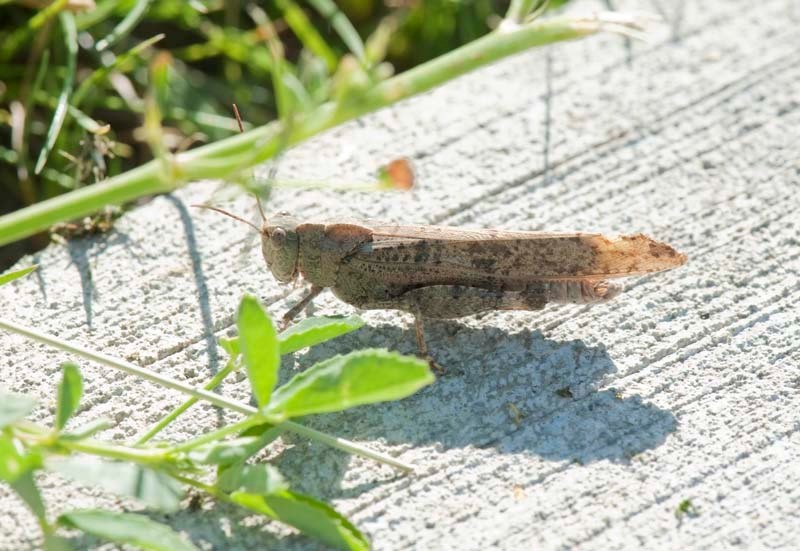I'm a bug fan, so I'm always alert for them whenever I'm out and about. Still, no matter how hard I look, there's one bug that always manages to surprise me: the Carolina grasshopper.
These sandy-brown, thumb-length ground-hoppers should be easy to spot due to their size, yet they're nearly invisible in practice, and all too easy to mistake for a clump of rock or dirt.
Then, when you're almost right on top of them, they'll leap almost a hundred times their height into the air, flare their huge, black wings, Batman-style, and zip away like a butterfly. Then they land and disappear once again.
They must be ninjas or something.
The Carolina grasshopper is one of the most widely distributed grasshoppers in North America, says Dan Johnson, an insect ecologist at the University of Lethbridge who's spent decades studying grasshoppers, and is found in every province and state. “They're some of the largest grasshoppers we have.”
The Carolina is also known as the road duster, says John “the Nature Nut” Acorn, an entomologist at the University of Alberta, and it's the only grasshopper around Edmonton with black hind wings with a white or yellow trim around the edge. “They have that beautiful sort of sandy colour,” he says of their bodies, although some can be reddish, chalky blue, or moss green.
The Carolina likes to hang around rocks and fine dirt and can usually be spotted sunning itself near roads and railway tracks – hence the name “road duster.” It's not a crop pest, Johnson notes, and prefers to snack on grass and weeds.
Carolinas are also known as butterfly grasshoppers due to their uncanny resemblance to mourning cloak butterflies in flight. “It's very effective,” Acorn says. “I've been mistaking them for mourning cloaks since I was a kid.”
Researchers have two theories about this resemblance, he continues. First, mourning cloaks are fast, agile creatures that birds find tough to catch, so by mimicking them, Carolinas might discourage some predators. “Birds look at them and go, 'Oh, forget it, it's one of those guys.'”
The second is surprise. By flashing its wings, flapping about and landing, grasshoppers go from terror-that-flaps-in-the-night to invisible rock in a heartbeat, which could confuse predators.
Unlike some grasshoppers, Johnson says the Carolina is pretty quiet. It flicks its legs a bit to draw mates, but you have to be within a few feet of it to hear it.
Carolinas rely more on sight and flight to find mates, Acorn says. Males are known to perform “hover flights” where they hover about a metre off the ground in one spot making a sprinkler-like sound for about five seconds before they land. “It's like a hummingbird.”
When they do find a mate, Carolinas (like most grasshoppers) show some impressive flexibility. “A lot of insects, years ago, mated end to end,” Johnson says, meaning they couldn't easily flee or feed while doing the deed. The Carolinas eventually figured out how to mate with the smaller male on top of the female, letting the latter feed or flee if needed.
Since their genitals are in the same place, however, the male has to contort its body to meet up with the female's reproductive organs. “You might call it a 'J' position,” Johnson says.
Carolinas (a.k.a. black-winged grasshoppers) are excellent fliers, Johnson says, able to hover, swing from side to side, and climb as high as 10 metres. “I've seen roadsides where, when a car goes by, thousands of black-winged grasshoppers will get up in the air,” he says. “It's amazing.”
Carolinas are an important food source for spiders and birds, Johnson says, and can have a great influence on their population. Since they're not great at digesting plants, Carolinas also concentrate nutrients in their droppings, fertilizing the land.
Adult Carolinas emerge in August, Acorn says, and should stick around until the snow falls. “To me, they're really a sign of late summer.”
Name:<br />Dissosteira carolina, a.k.a. road duster, black-winged grasshopper, butterfly grasshopper.<br /> <br />Appearance:<br />Sandy coloured grasshopper, up to six centimetres long. Wings in flight are black with a yellow or white edge.<br /><br />Commonly seen:<br />Along roads or railways, leaping out of nowhere to flash their big black wings to confuse entomologists.<br /><br />Occasionally confused with:<br />Mourning cloak butterflies.<br /><br />Fun fact:<br />They can hover like a hummingbird to attract mates.
Like wildlife? So do we! Every second Wednesday (or Saturday) the Gazette profiles a reasonably common wild creature in the St. Albert region. Birds, beasts, bugs, fish … so long as it's alive and kicking, we'll feature it. <br /><br />Got a creature you'd like to see profiled? Send your suggestions to [email protected].




